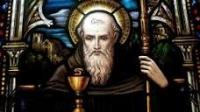
Feast day: 11 July
The only ancient account of St Benedict’s life, apart from a short poem, is found in the second volume of Pope Gregory I’s four-book Dialogues, thought to have been written in 593 (though the authenticity of the work is disputed). It is not biography in the modern sense, though his anecdotes are based on the testimony of four monks who knew Benedict: Constantinus, who succeeded Benedict as Abbot of Monte Cassino, Honoratus, who was abbot of Subiaco when Gregory wrote his Dialogues, Valentinianus and Simplicius. The writings are more of a hagiography with historical details, designed to teach spiritual lessons, and took the form of a conversation between the pope and his deacon Peter.
Born in the year 480, Benedict was the son of a Roman noble of Nursia. He was sent to Rome to study but was disappointed by the life he found there. He left the city with his nurse as his servant and settled in Enfide (modern Affile), about 64 kilometres from Rome. Benedict then met a monk called Romanus, whose monastery was on a mountain. After some discussion Romanus gave Benedict a monk’s habit, and for three years he lived in a cave below the monastery. Romanus cared for Benedict and brought him food. During his solitude in the cave Benedict matured and gained the respect of those who encountered him. On the death of of the abbot of a nearby monastery (identified by some as Vicovaro), the community came to him and begged him to become its abbot. The task was difficult as, “their manners were diverse from his and that therefore they would never agree together...” He gave his consent; however hostility towards him grew and the monks tried to poison him. He prayed a blessing over the cup and it shattered. He left the group and went back to his cave. Nearby was a priest called Florentius who was envious of Benedict and tried to kill him with poisoned bread. The saint prayed over the bread and a raven swept in and carried the loaf off. Tales of his miracles abounded, and peopled flocked to obtain his advice. He founded twelve monasteries in the area in which he lived. Florentius then tried to seduce his monks with some prostitutes, so Benedict moved away and in 530 founded the monastery of Monte Cassino, which lies on the hilltop between Naples and Rome.
During his invasion of Italy, the King of the Goths ordered a general to wear his robes to see if Benedict would recognise him in disguise. Benedict detected the deception and Totila respected him.
Benedict is said to have died of a fever not long after his twin sister St Scholastica, and was buried with her. The traditional day of his death was 21 March 547. He is one of the patrons of Europe.
Monasticism preceded Benedict, stemming originally from the eremite fathers of the desert, who eventually came together in communities. However, Benedict compiled a rule for his monks, with the view to establishing a way of life, helpful to communal living and exercising moderation in its demands. He probably took inspiration from the Rules of St Augustine and St John Cassian, and he was aware also of the Rule of St Basil as he had commended it. Benedict’s Rule covers discipline, running of the monastery and the quality of the personnel, the emphasis being on prayer, work and study. It has been adopted by many communities of monks and nuns. The Cistercians are a branch of the Benedictine family.
St Benedict of Nursia, father of western monasticism, pray for us.